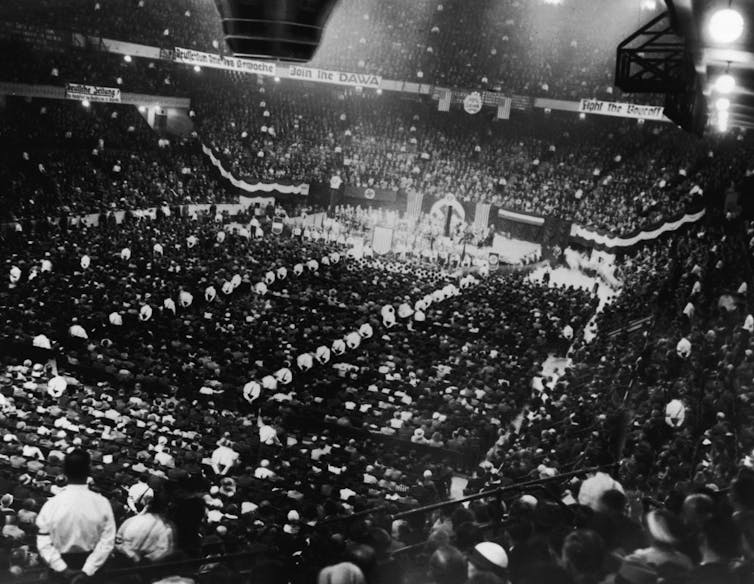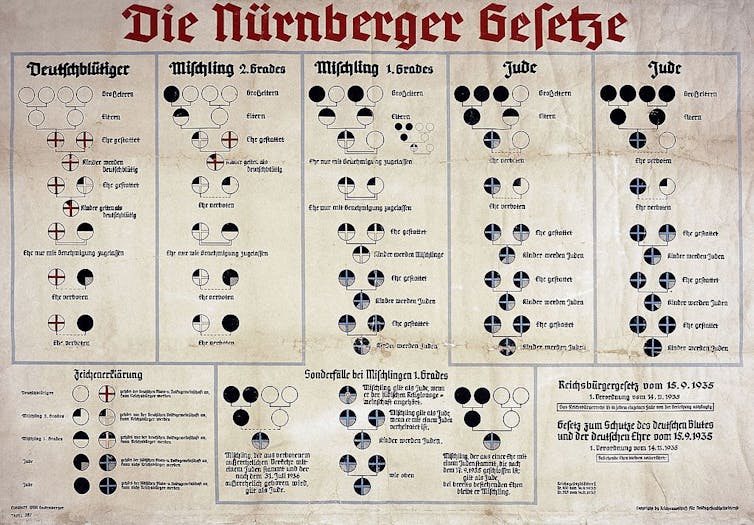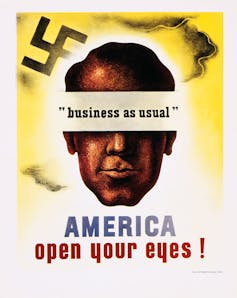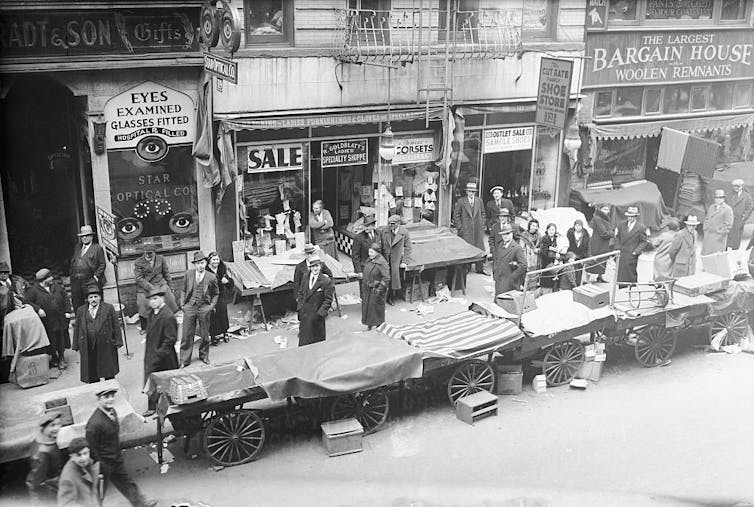Legacy of shame
Meghan Garrity, George Mason University and Melissa Jo Wilde, University of Pennsylvania
 |
| Thousands of people attend a pro-Nazi rally at Madison Square Garden in New York in May 1934, with counterprotestors outside. Anthony Potter Collection/Hulton Archive via Getty Images |
Eighty-eight years later, the United States is facing rising antisemitism and white supremacist ideology – including two neo-Nazi demonstrations in Florida in September 2023 alone.
The Nuremberg Laws were a critical juncture on the Third Reich’s path toward bringing about “the full-scale creation of a racist state … on the road to the Holocaust,” according to legal historian James Whitman. Yet across the Atlantic, many Americans were unconcerned, and even admiring – including some religious leaders.
As a political scientist and a sociologist, we wanted to examine what Americans thought about Hitler and the National Socialist Party before the U.S. entered World War II – and see what lessons those findings might hold for our country today. Our recent research, which focused on religious publications, suggests that Americans’ support for Nazi Germany is best explained by belief in white supremacy.
View from the pulpit
In 1935, Adolf Hitler entered his third year in power and legally solidified the Nazi regime’s racist policies. During this period, Jews, Romani, homosexuals, the mentally or physically disabled and African-Germans were all targets of Hitler’s wrath. Thousands of refugees fled the country in search of safety – many to U.S. shores.
 |
| Chart from Nazi Germany showing the regime’s racial categorizations under the Nuremberg Laws of 1935. Universal History Archive/Universal Images Group via Getty Images |
Individual public opinion data about Nazi Germany is not available for this period; Gallop’s first survey on the topic was conducted in 1938. Instead, we used a database of periodicals from religious organizations that one of us,
Wilde, had originally compiled for a book on views of contraception in the early 20th century. Using these periodicals, we examined the views of leaders in 25 of the United States’ most prominent religious groups.
In the 1930s, the U.S. was a far more religious country than it is today, with around 95% of Americans claiming membership in a religious denomination. The groups in our sample include 82% of Americans who reported religious membership at the time.
Most are white Protestant denominations, but our sample also included Roman Catholics, three Jewish groups, Black churches, and smaller groups like Jehovah’s Witnesses and the Church of Jesus Christ of Latter-day Saints.
We argue that while these texts are not necessarily representative of individual members’ views, they are evidence of the views religious elites tried to cultivate in large segments of the American population.
‘Unequaled in cruelty’
These periodicals dispel the notion that Americans did not know, or understand, the gravity of the situation in Germany at the time. A third of the denominations in our sample were critical of Hitler, and their alarm demonstrates that ample information was available about the escalating situation in Nazi Germany.
 |
| A poster designed by Jean Carlu for Fortune magazine in 1941. swim ink 2 llc/Corbis Historical via Getty Images |
These groups, which were both Christian and Jewish, wrote about “the omnipresent terror that grips every town and hamlet”; the German concentration or “education camps”; and the number of people jailed, sent to camps, killed or sterilized.
Leaders of Conservative Judaism warned that “German Jewry is on the way to extinction.” The Universalist General Convention described the situation in Germany as “unequaled in cruelty and brutality even by the Spanish Inquisition.”
On the other end of the spectrum, religious leaders from the Norwegian Lutheran Church, which has long since merged with other denominations, emphasized that Hitler was legitimately elected and enjoyed strong support among the German people.
Another article recounted a recent trip to Germany, writing that “what we interpret as militarism” is a manifestation of support for “the program of Hitler” and “the common good.”
The Presbyterian Church in the U.S. – a white Southern denomination that later merged with other Presbyterian denominations – wrote of Hitler’s regime making “effort[s] toward social justice” with reforms for illegitimate children.
And while some religious elites sympathetic to Hitler acknowledged that the Nazis’ tactics were unsavory, they suggested “the means do not, taken by themselves, condemn the end.”
Finding the pattern
As we analyzed the periodicals, we classified leaders’ writings into four categories. Beyond groups that clearly sympathized with Hitler or criticized him, the largest number were ambivalent, with mixed views. Others were “distant,” barely commenting on events in Europe.
We found that two main factors explain religious elites’ views of Hitler in 1935. The first is whether their group embraced white supremacist ideas. The second is whether they were atop the religious hierarchy – that is, mainstream Protestant denominations whose members would not have been at risk of persecution in Germany.
Groups that consistently criticized Hitler had members that were marginalized because of their race or ethnicity. They regularly spoke out against prejudice, segregation and lynching. In contrast, denominations that were well established and mostly white tended to be ambivalent toward Nazism, even those that spoke out against anti-Black racism in the U.S.
 |
| Jewish pushcart workers on New York’s Lower East Side participated in a two-hour protest in 1933, refusing to make sales, during a day of mass demonstrations against the persecution of German Jews. Bettmann via Getty Images |
Importantly, the groups that supported Hitler were also antisemitic and eugenicists, believing human beings could be “perfected” through selective breading.
However, antisemitism was rampant at the time, even among groups that were ambivalent about Hitler. Similarly, support for eugenics was too broad to explain why certain religious groups in the U.S. sympathized with the Nazis.
There were even religious leaders who criticized Hitler yet had connections to the American Eugenics Movement, which promoted forced sterilization laws and, later, the legalization of birth control.
Instead, what most strongly differentiated Hitler’s sympathizers in this era was their belief in white supremacy vis-a-vis African Americans. These groups published literature claiming that African Americans were physically and mentally inferior, and one wrote positively of the Ku Klux Klan.
A Southern Baptist bishop wrote, “The Negro is not like the white man … there are striking differences physical and mental,” going on to claim, “the white race … assumes its superiority in strength and capacity.”
Fast-forward
Although 1935 is nearly a century behind us, U.S. politics has been awash in comparisons to the Third Reich for several years now. Former President Donald Trump recently compared his indictments to Nazi Germany, obfuscating the mass atrocities of Hitler’s regime.
But such comparisons do prompt reflection on what drove American support for Nazi Germany in the 1930s, as Trump campaigns with an authoritarian vision for his second term, and as white nationalism remains a major aspect of U.S. politics.
In 1935, Europe was not at war, and concern about mass killings would have seemed alarmist. Yet just a few years later, a global conflagration began. On the anniversary of the Nuremberg Laws, what motivated American support for Hitler’s authoritarianism in the 1930s still resonates today.![]()
Meghan Garrity, Assistant Professor of International Security & Law, George Mason University and Melissa Jo Wilde, Professor and Chair of Sociology, University of Pennsylvania
This article is republished from The Conversation under a Creative Commons license. Read the original article.
